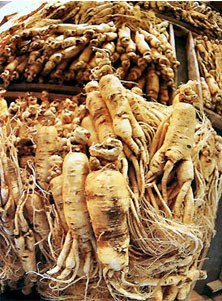|
|
|
| The History of Ginseng |
Ginseng is recognized as the king of all herbs in Asia. Enhances the immune system effective against cancer, diabetes, auto-immune disorders, blood related disorders, fatigue and aging. Efficacies well documented in 5,000+ years of medical history. Exclusively used by emperors and the affluent in the past. Non-toxic, non-stimulant, no adverse effect.
According to legend, it was the ancient mythical emperor Shen Nong who discovered the wondrous root. He lived around 2700 B.C. and is considered to be the father of agriculture and herbal therapy. He is also credited as the author of the first pharmacopoeia, the Ben Chao Shen Nong, a book recounting the entire body as medical knowledge as it was known up to that time. This book said Ginseng calms the mind, brings harmony to the soul eliminates fears, and drives away evil spirits. It also makes the eyes shine, opens the heart, and clarifies thinking. If taken long enough, they claimed, it strengthens the body and extends life.
|
|
 |
|
|
Chinese doctors have been using the root of the ginseng plant for nearly 5,000 years. Because of its healing power, it was much in demand and its price is even more valuable than gold. In ancient China, ginseng was reserved only for the emperors; today, you can take advantage of its numerous effects. The various kinds of ginseng differ greatly in quality. The curative power of ginseng depends on the way it is cultivated, the time it is given to grow and ripen, and the manner in which it is processed.
Ginseng is primarily known as a strengthening substance for older people, because the body needs special support during the aging process. Younger people can also benefit from ginseng. Ginseng helps children and teenagers concentrate better at school and in their studies. Adults receive the necessary balance that is needed to master the periods of stress in their private and professional lives. You can strengthen your immune system with ginseng as well as treat a range of specific ailments. Ginseng is also beneficial as an adjunct in the treatment of serious illnesses and accelerates the healing process.
|
|
| The Characteristics of Ginseng |
 |
Ginseng grows mostly in the wooded mountains of China and Korea. Its long root is said to work wonders. Its shape resembles that of a human being, with parts that look like a head, arms, trunk, and legs. The shape itself seems to indicate that the root is powerful and effective in treating the entire human body.
|
|
 |
Ginseng is cultivated all over the world today. Ginseng comes from Korea, China, Japan, Thailand. Russia, America, and Canada. Ginseng is not categorized as a medical plant in many countries, but rather as a health food.
|
|
 |
Different kinds of ginseng are cultivated in different areas. They differ in their content of active agents and their overall effectiveness.
|
|
 |
Only two kinds of ginseng are medicinally considered genuine: the Chinese-Korean Panax ginseng (Bing Han ginseng) and the Canadian Panax quinquefolius. Because of the diversity of its active agents and the richness of its effects, Chinese-Korean Panax ginseng is described as the king or emperor of all herbal remedies.
|
|
 |
Because ginseng is effective in so many different ways, it is easy to understand why the soil, climate, region, and care during cultivation play such important roles. The best and most balanced spectrum of effectiveness can only develop if the plant grows under optimal conditions.
|
|
 |
Natural Bing Han ginseng is nurtured for a six-year period before it matures into an adult plant to be harvested. The land is then left idle for 15 years to replenish its nutrients. No chemicals or chemical fertilizers are added to the soil where the ginseng grows.
|
|
|
|

